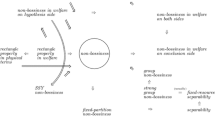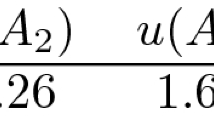Abstract
This essay is a didactic introduction to the literature on the “consistency principle” and its “converse”. An allocation rule is consistent if for each problem in its domain of definition and each alternative that it chooses for it, then for the “reduced problem” obtained by imagining the departure of an arbitrary subgroup of the agents with their “components of the alternative” and reassessing the options open to the remaining agents, it chooses the restriction of the alternative to that subgroup. Converse consistency pertains to the opposite operation. It allows us to deduce that a rule chooses an alternative for a problem from the knowledge that for each two-agent subgroup, it chooses its restriction to the subgroup for the associated reduced problem this subgroup faces. We present two lemmas that have played a critical role in helping understand the implications of these properties in a great variety of models, the Elevator Lemma and the Bracing Lemma. We describe several applications. Finally, we illustrate the versatility of consistency and of its converse by means of a sample of characterizations based on them.
Similar content being viewed by others
References
Aumann R, Maschler M (1985) Game theoretic analysis of a bankruptcy problem from the Talmud. J Econ Theo 36: 195–213
Balinski M, Young P (1982) Fair representation. Yale University Press, New Haven
Bevia C (1996) Identical preferences lower bound solution and consistency in economies with indivisible goods. Soc Choice Welfare 13: 113–126
Chambers C (2004) Consistency in the probabilistic assignment model. J Math Econ 40: 953–962
Chun Y (1999) Equivalence of axioms for bankruptcy problems. Int J Game Theory 28: 511–520
Chun Y (2002) The converse consistency principle in bargaining. Games Econ Behav 40: 25–43
Chun Y (2011) Consistency and monotonicity in sequencing problems. Int J Game Theory 40: 29–41
Dagan N (1996) A note on Thomson’s characterizations of the uniform rule. J Econ Theory 96: 255–261
Dagan N, Volij O (1997) Bilateral comparisons and consistent fair division rules in the context of bankruptcy problems. Int J Game Theory 26: 11–25
Davis M, Maschler M (1965) The Kernel of a cooperative game. Naval Res Logis Q 12: 223–259
Dutta B (1990) The egalitarian solution and reduced game properties in convex games. Int J Game Theory 19: 153–169
Dutta B, Kar A (2004) Cost monotonicity, consistency, and minimum cost spanning tree games. Games Econ Behav 48: 223–248
Ehlers L, Klaus B (2006) Efficient priority rules. Games Econ Behav 55: 372–384
Ergin H (2000) Consistency in house allocation problems. J Math Econ 34: 77–97
Fleurbaey M, Maniquet F (1996) Fair allocation with unequal production skills: the solidarity approach to compensation. Math Soc Sci 32: 71–93
Gale D, Shapley LS (1962) College admissions and the stability of marriage. Am Math Mon 69: 9–15
Gillies DB (1959) Solutions to general non-zero sum games. In: Tucker AW, Luce RD (eds) Contributions to the theory of games IV, annals of mathematical studies 40. Princeton University Press, Princeton, pp 595–614
Hart S, Mas-Colell A (1988) The potential of the Shapley-value, Chapter 9 in the shapley-value: essays in honor of Lloyd S. Shapley Roth AE (ed), Cambridge University Press, pp 127–137
Hokari T (2005) Consistency implies equal treatment in TU games. Games Econ Behav 51: 63–82
Hokari T, Kıbrıs O (2003) Consistency, converse consistency, and aspirations in coalitional games. Math Soc Sci 45: 249–297
Hokari T, Thomson W (2008) On properties of division rules lifted by bilateral consistency. J Math Econ 44: 1057–1071
Hwang Y-A, Yeh C-H, Ju B-G (2006) Reduction-consistency and the Condorcet principle in collective choice problems, mimeo
Ju B-G (2008) Efficiency and consistency for locating multiple public facilities. J Econ Theory 138: 165–183
Kalai E (1977) Proportional solution to bargaining problems: interpersonal utility comparisons. Econometrica 45: 1023–1030
Kalai E, Smorodinsky M (1975) Other solutions to Nash’s bargaining problem. Econometrica 43: 513–518
Klaus B, Nichifor A (2010) Consistency in one-sided assignment problems. Soc Choice Welfare 35: 415–433
Lensberg T (1987) Stability and collective rationality. Econometrica 55: 935–961
Lensberg T (1988) Stability and the Nash solution. J Econ Theory 45: 330–341
Maniquet F (1996) Horizontal equity and stability when the number of agents is variable in the fair division problem. Econ Lett 50: 85–90
Maschler M, Owen G (1989) The consistent shapley-value for hyperplane games. Int J Game Theory 18: 390–407
Moulin H (1987) Equal or proportional division of a surplus, and other methods. Int J Game Theory 16: 161–186
Moulin H (1988) Axioms of cooperative decision making. Cambridge University Press, Cambridge
Nash J (1950) The bargaining problem. Econometrica 18: 155–162
O’Neill B (1982) A problem of rights arbitration from the Talmud. Math Soc Sci 2: 345–371
Özkal-Sanver I (2009) Minimal converse consistent extension of the men-optimal solution, mimeo
Peleg B (1985) An axiomatization of the core of cooperative games without side-payments. J Math Econ 14: 203–214
Peleg B (1986) On the reduced game property and its converse. Int J Game Theory 15 , 187–200. A correction. International Journal of Game Theory 16 (1987)
Peleg B, Tijs S (1996) The consistency principle for games in strategic form. Int J Game Theory 25: 13–34
Potters JAM, Sudhölter P (1999) Airport problems and consistent solution rules. Math Soc Sci 38: 83–102
Roemer J (1988) Axiomatic bargaining on economic environments. J Econ Theory 45: 1–31
Sasaki H (1995) Consistency and monotonicity in assignment problems. Int J Game Theory 24: 373–397
Sasaki H, Toda M (1992) Consistency and characterization of the core of two-sided matching problems. J Econ Theory 56: 218–227
Schmeidler D (1969) The nucleolus of a characteristic function game. SIAM J Appl Math 17: 1163–1170
Serrano R (1995) Strategic bargaining, surplus sharing and the nucleolus. J Math Econ 24: 319–329
Shapley L (1953) A value for n-person games. In: Kuhn HW, Tucker AW (eds) Contributions to the theory of games II (annals of matheLLLmatics studies 28). Princeton University Press, Princeton, pp 307–317
Shapley L, Shubik M (1972) The assignment game I: the core. Int J Game Theory 1: 111–130
Sobolev AI (1975) The characterization of optimality principles in cooperative games by functional equations. Math Methods Soc Sci 6: 150–165 (in Russian)
Sprumont Y (1991) The division problem with single-peaked preferences. Econometrica 59: 509–519
Svensson L-G (1983) Large indivisibilities: an analysis with respect to price equilibrium and fairness. Econometrica 51: 939–954
Tadenuma K (1992) Reduced games, consistency, and the core. Int J Game Theory 20: 325–334
Tadenuma K, Thomson W (1991) No-envy and consistency in economies with indivisible goods. Econometrica 59: 1755–1767
Tadenuma K, Thomson W (1993) The fair allocation of an indivisible good when monetary compensations are possible. Math Soc Sci 25: 117–132
Thomson W (1983) The fair division of a fixed supply among a growing population. Math Oper Res 8: 319–326
Thomson W (1988) A study of choice correspondences in economies with a variable number of agents. J Econ Theory 46: 247–259
Thomson W (1994a) Consistent solutions to the problem of fair division when preferences are single-peaked. J Econ Theory 63: 219–245
Thomson W (1994b) Consistent extensions. Math Soc Sci 28: 35–49
Thomson W (2003) Axiomatic and game-theoretic analysis of bankruptcy and taxation problems: a survey. Math Soc Sci 45: 249–297
Thomson W (2010a) Fair allocation rules. In: Arrow K, Sen A, Suzumura K (eds) Handbook of social choice and welfare. North-Holland, Amsterdam, pp 393–506
Thomson W (2010b) On the computational implications of converse consistency, University of Rochester mimeo
Thomson W (2011a) Lorenz rankings of rules for the adjudication of conflicting claims. Economic Theory (forthcoming)
Thomson W (2011b) Consistent allocation rules, monograph
Toda M (2003) Consistency and its converse in assignment games. Int J Math Game Theory Algebra 13: 1–14
Toda M (2006) Monotonicity and consistency in matching markets. Int J Game Theory 34: 13–31
Yeh C-H (2006) Reduction-consistency in collective choice problems. J Math Econ 42: 637–652
Young P (1987) On dividing an amount according to individual claims or liabilities. Math Oper Res 12: 398–414
Young P (1988) Distributive justice in taxation. J Econ Theory 44: 321–335
Author information
Authors and Affiliations
Corresponding author
Additional information
I thank Julio Gonzalez, Bettina Klaus, Eiichi Miyagawa and Karol Szwagrzak for helpful comments and the NSF under grant 0721107 for its support.
Rights and permissions
About this article
Cite this article
Thomson, W. Consistency and its converse: an introduction. Rev Econ Design 15, 257–291 (2011). https://doi.org/10.1007/s10058-011-0109-z
Received:
Accepted:
Published:
Issue Date:
DOI: https://doi.org/10.1007/s10058-011-0109-z




